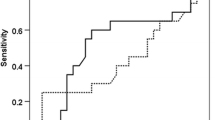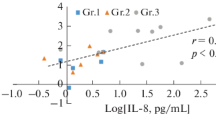Abstract
To evaluate the predictive value of protein C as a marker of severity in patients with diffuse peritonitis and abdominal sepsis, protein C levels were repeatedly determined and compared with serum levels of antithrombin III, plasminogen, α2-antiplasmin, Plasminogen activator inhibitor, D-dimer, C1-inhibitor, high molecular weight kininogen, and the C5a, C5b-9 fragments of the complement system. We carried out a prospective study from 44 patients with severe peritonitis confirmed by laparotomy and 15 patients undergoing elective ventral hernia repair who acted as controls. Analyzed biochemical parameters were determined before operations and on days 1, 2, 3, 5, 7, 10, and 14 after operations. For the study group, preoperative average protein C level was significantly lower in the patients who developed septic shock in the late course of the disease, with lethal outcome, than in the patients with severe peritonitis and sepsis who survived (p = 0.0001). In non-survivors, protein C activity remained decreased below 70%, whereas the course of survivors was characterized by increased values that were significantly higher (p < 0.03) at every time point than in those patients who died. Protein C was of excellent predictive value and achieved a sensitivity of 80% and a specificity of 87.5% in discriminating survivors from non-survivors within the first 48 hours of the study (AUC-0.917; p < 0.001), with a “cut-off” level of 66.0%. As for the control group, throughout the study period, protein C activity was permanently maintained within the range of normal, with significant differences with reference to the study group (p < 0.01). These results suggest that protein C represents a sensitive and early marker for the prediction of severe septic complications during diffuse peritonitis, and of outcome.

Similar content being viewed by others
References
AE Baue R Durham E. Faist (1998) ArticleTitleSystemic inflammatory response syndrome (SIRS), multiple organ dysfynction syndrome (MODS), multiple organ failure (MOF): are we winning battle? Shock 10 79–89 Occurrence Handle9721973
DH Wittmann C Aprahamian JM Bergstein et al. (2000) ArticleTitleSTAR and STIR effectively treat abdominal compartment syndrome and reduce mortality of traumatic and infectious abdominal catastrophes J. Int. Care Med. 15 201–220 Occurrence Handle10.1046/j.1525-1489.2000.00201.x
EH Farthmann U. Schoffel (1990) ArticleTitlePrinciples and limitations of operative management of intaabdominal infections World J. Surg. 14 210–217 Occurrence Handle10.1007/BF01664875 Occurrence Handle2183484
JM Garcia-Sabrido JM Talado NV. Christou (1988) ArticleTitleTretment of severe intaabdominal sepsis and/or necrotic foci by an open abdomen approach: Zipper and zipper-mesh techniques Arch. Surg. 123 152–156 Occurrence Handle3277582
D. Berger (1996) ArticleTitleThe role of endotoxin in peritonitis Dig. Surg. 13 384–389
AC Carvalho NJ. Freeman (1994) ArticleTitleHow coagulation defects alter outcome in sepsis J. Crit. Illness 9 51–75
J Boldt (2001) Changes of the hemostatic network in the critically ill JL Vincent (Eds) Yearbook of Intensive Care and Emergency Medicine Springer-Verlag Berlin 287–295
M Schein DH Wittman R Holzheimer et al. (1996) ArticleTitleHypothesis: compartmentalizacion of cytokines in intra-abdominal infection Surgery 11 694–700
GR Bernard DL Hartmann JD Helterbrand et al. (1999) ArticleTitleRecombinant human activated protein C (rhAPC) produces a trend toward improvement in morbidity and 28-day survival in patients with severe sepsis Crit. Care Med. 27 S33–S35 Occurrence Handle10.1097/00003246-199901001-00024
GR Bernard WL Macias DE Joyce et al. (2003) ArticleTitleSafety assessment of drotrecogin alfa (activated) in the treatment of adult patients with severe sepsis Crit. Care 7 155–163 Occurrence Handle10.1186/cc2167 Occurrence Handle12720562
SB Yan JF. Dhainaut (2001) ArticleTitleActivated protein C versus protein C in severe sepsis Crit. Care Med. 29 S69–S74 Occurrence Handle10.1097/00003246-200107001-00024 Occurrence Handle11445737
JF Dhainaut SB Yan A Cariou et al. (2002) ArticleTitleSoluble thrombomodulin, plasma-derived unactivated protein C, and recombinant human activated protein C in sepsis Crit. Care Med. 30 S318–S323 Occurrence Handle10.1097/00003246-200205001-00023 Occurrence Handle12004254
GR Bernard JL Vincent PF. Laterre (2001) ArticleTitleEfficiacy and safety of recombinant human activated protein C for severe sepsis N. Engl. J. Med. 344 699–709 Occurrence Handle10.1056/NEJM200103083441001 Occurrence Handle11236773
MR Mesters J Helterbrand B Utterback et al. (2000) ArticleTitlePrognostic value of protein C concentrations in neutropenic patients at high risk of severe septic complications Crit. Care Med. 28 2209–2216 Occurrence Handle10.1097/00003246-200007000-00005 Occurrence Handle10921542
RA Marlar BJ Endres C. Miler (1985) ArticleTitleSerial studies of protein C and its plasma inhibitor in patients with DIC Blood 66 59–63 Occurrence Handle3924142
E Jonge ParticleDe M Levi T Poll ParticleVan der (2001) Natural anticoagulants in disseminated intravascular coagulation and sepsis JL Vincent (Eds) Yearbook of Intensive Care and Emergency Medicine Springer-Verlag Berlin 348–352
DL Hartmann GR. Bernard (1998) ArticleTitleProtein C activity by baseline predicts the development of shock and 28 day mortality in patients with severe sepsis Intens. Care Med. 24 S138–S148 Occurrence Handle10.1007/s001340050535
F Fourrier C Chopin J. Goudemand (1992) ArticleTitleSeptic shock, multiple organ failure and disseminated intravascular coagulation. Compared patterns of AT III, protein C and protein S deficiences Chest 101 816–823 Occurrence Handle1531791
JF Hesselvik J Malm BF. Dahlback (1991) ArticleTitleProtein C, protein S and C4b binding protein in severe infection and septic shock Thromb. Haemost. 65 126–129 Occurrence Handle1828915
JL Vincent DC Angus A Artigas et al. (2003) ArticleTitleEffects of drotrecogin alfa (activated) on organ dysfunction in the PROWES trial Crit. Care Med. 31 834–840 Occurrence Handle10.1097/01.CCM.0000051515.56179.E1 Occurrence Handle12626993
AO. Aasen (1985) ArticleTitleThe proenzyme functional inhibition index. A new parameter for evaluation of the severely injured and septic patients Acta Chir. Scand. 522 211–233
AO Aasen (1990) The role of proteolytic enzyme systems with particular emphasis on the plasma kalikrein-kinin system during septicemia and septic shock JL Vincent LG Thijs (Eds) Septic Shock Springer-Verlag Berlin 16–128
JC Meijers BN. Bouma (1999) ArticleTitleNew concepts in activation of the clotting cascade in sepsis Sepsis 3 87–91 Occurrence Handle10.1023/A:1009887130463
American College of Chest Physicians/Society of Critical Care Medicine. Definitions for sepsis and organ failure and guidelines for the use of innovative therapies in sepsis. Crit. Care Med. 1992; 20: 864–874
DA Anaya AB. Nathens (2003) ArticleTitleRisk factors for severe sepsis in secondary peritonitis Surg. Infect. 4 355–362 Occurrence Handle10.1089/109629603322761418
B Rau CM Kruger MK. Schilling (2004) ArticleTitleProcalcitonin: improved biochemical severity stratification and postoperative monitoring in severe abdominal inflammation and sepsis Langenbecks Arch. Surg. 389 134–144 Occurrence Handle10.1007/s00423-004-0463-1 Occurrence Handle15007651
W Teichman B. Herbig (1996) ArticleTitleScheduled reoperations for diffuse peritonitis Dig. Surg. 13 396–399
DH Wittman M Schein RE. Condon (1996) ArticleTitleManagement of secondary peritonitis Ann. Surg. 224 10–18 Occurrence Handle10.1097/00000658-199607000-00003 Occurrence Handle8678610
DH. Wittmann (1998) ArticleTitleOperative and nonoperative therapy of intra-abdominal infections Infection 26 335–351 Occurrence Handle9795802
M Levi T Poll Particlevan der H ten Gate et al. (1997) ArticleTitleThe cytokine-mediated imbalance between coagulant and anticoagulant mechanisms in sepsis and endotoxemia Eur. J. Clin. Ivest. 27 3–9 Occurrence Handle10.1046/j.1365-2362.1997.570614.x
WL Macias PrefixDR. Nelson (2004) ArticleTitleSevere protein C deficiency predicts early death in severe sepsis Crit. Care Med. 32 S223–S228 Occurrence Handle10.1097/01.CCM.0000126120.49367.AC Occurrence Handle15118522
JA Hazelzet E Voort Particlevan der J Lindermans et al. (1994) ArticleTitleRelation between cytokines and routine laboratory data in children with septic shock and purpura Intens. Care Med. 20 371–374 Occurrence Handle10.1007/BF01720912
K Fijnvandraat B Derkx M Peters et al. (1995) ArticleTitleCoagulation activation and tissue necrosis in meningococcal septic shock: severely reduced protein C levels predict a high mortality Thromb. Haemost. 73 15–20 Occurrence Handle7740486
J Roman F Velasco F Fernandez et al. (1992) ArticleTitleProtein C, protein S and C4b binding protein in neonatal severe infection and septic shock J. Perinat. Med. 20 111–116 Occurrence Handle1386881
F Leclerc J Hazelzet B Jude et al. (1992) ArticleTitleProtein C and S deficiency in severe infectious purpura of children: a collaborative study of 40 cases Intens. Care Med. 18 202–205 Occurrence Handle10.1007/BF01709832
D Powars R Larsen J Johnson et al. (1993) ArticleTitleEpidemic meningococcemia and purpura fulminans with induced protein C deficiency Clin. Infect. Dis. 17 254–261 Occurrence Handle8399877
JA Lorente LJ Garcia-Frade L Landin et al. (1993) ArticleTitleTime course of hemostatic abnormalities in sepsis and its relation to outcome Chest 103 1536–1542 Occurrence Handle8486040
CJ Fisher SuffixJr SB. Yan (2000) ArticleTitleProtein C levels as a prognostic indicator of outcome in sepsis and related diseases Crit. Care Med. 28 S49–S56 Occurrence Handle10.1097/00003246-200009001-00011 Occurrence Handle11007198
SM Pastores E Papadopulos M Brink Particlevan den et al. (2002) ArticleTitleSeptic shock and multiple organ failure after hematopoetic stem cell transplantation: treatment with recombinant human activated protein C Bone Marrow Transplant. 30 131–134 Occurrence Handle10.1038/sj.bmt.1703618 Occurrence Handle12132053
WL Macias PA. Derchak (2003) ArticleTitleCoagulopathy may occur before the clinical diagnosis of organ dysfunction Crit. Care Med. 31 S100–S110
Author information
Authors and Affiliations
Corresponding author
Rights and permissions
About this article
Cite this article
Karamarkovic, A., Radenkovic, D., Milic, N. et al. Protein C as an Early Marker of Severe Septic Complications in Diffuse Secondary Peritonitis. World J. Surg. 29, 759–765 (2005). https://doi.org/10.1007/s00268-005-7771-7
Published:
Issue Date:
DOI: https://doi.org/10.1007/s00268-005-7771-7




